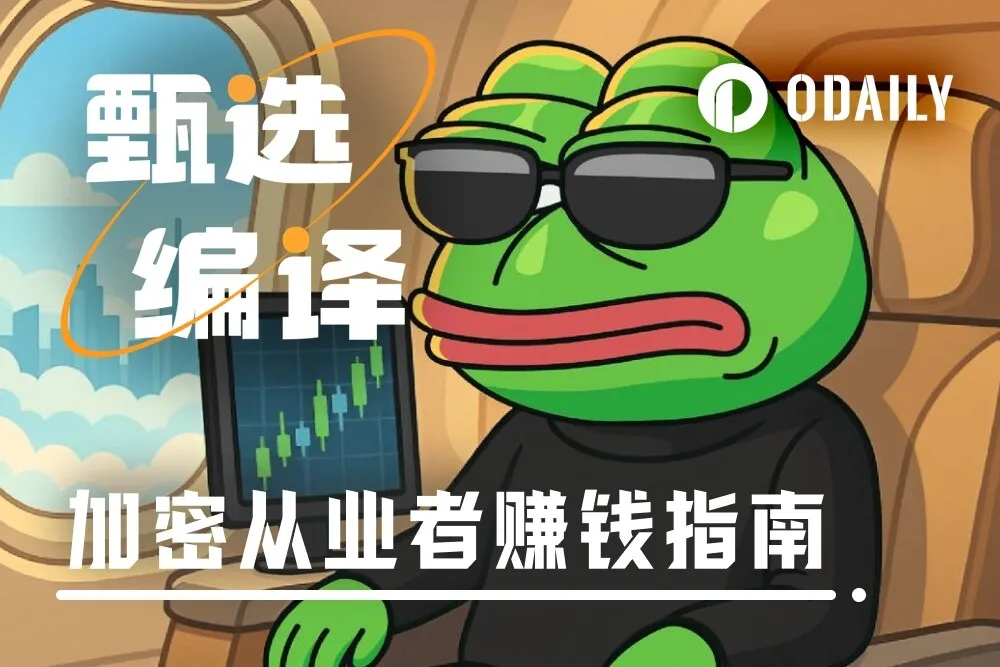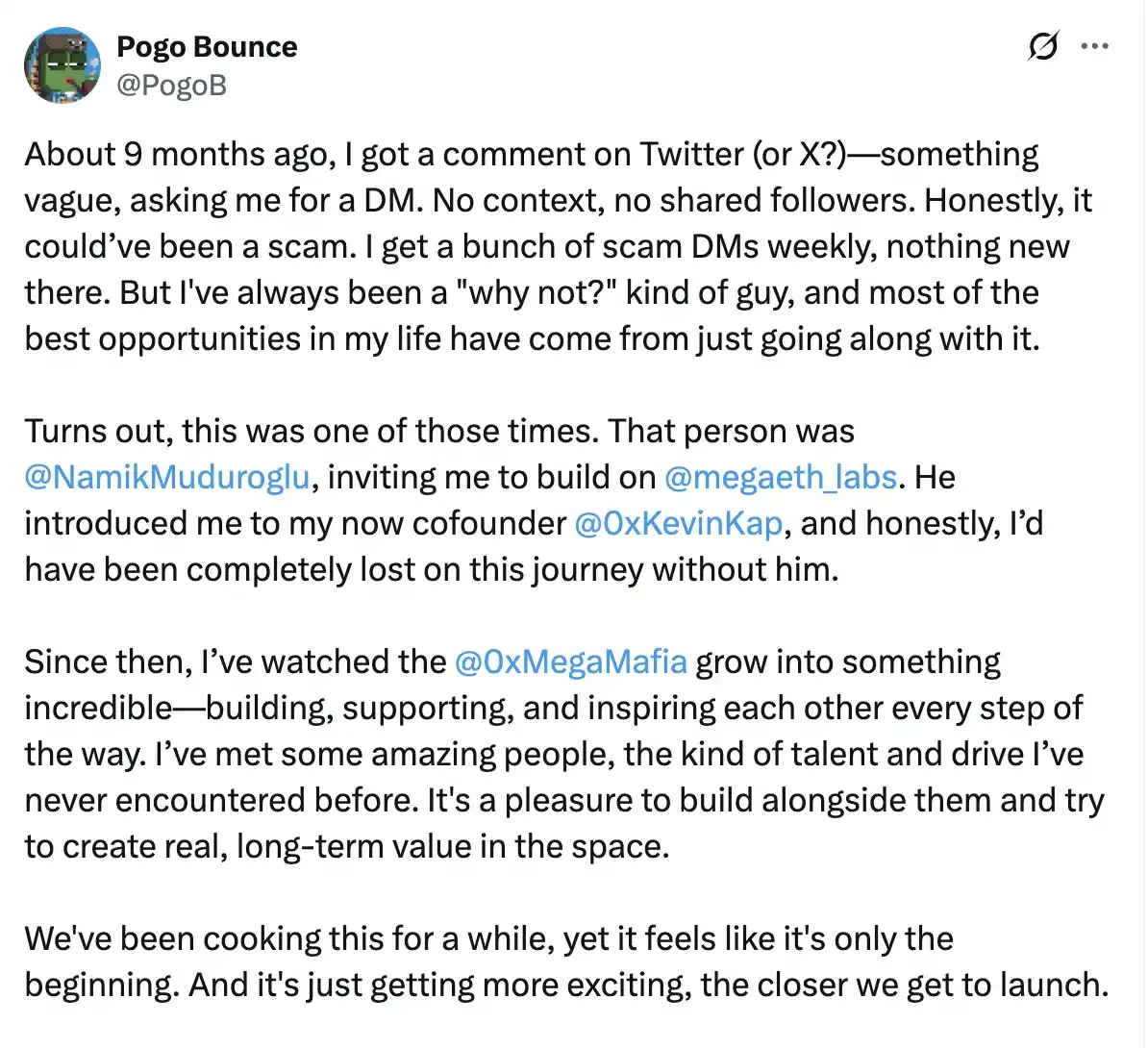Written by: Coinmonks
Translated by: Baihua Blockchain
At the beginning of this year, a clear public signal indicated that the focus is shifting.
In early October, Hyperliquid launched its permissionless listing (HIP-3). Now, builders can launch perpetual contract markets by staking 500,000 HYPE, while setting restrictions such as validator penalties and open interest limits. This move coincides with decentralized perpetual contracts reaching new highs in market share competition with CEXs, further fueling the narrative that "on-chain is winning."
Meanwhile, CZ (founder of Binance) responded on X to rumors about Hyperliquid's association, even intervening in a widely discussed post about "shorting $1 billion on Hyperliquid." Whether you interpret it as concern or simple rumor control, the fact that the Binance founder publicly mentioned a DEX is enough to indicate where the attention has shifted.
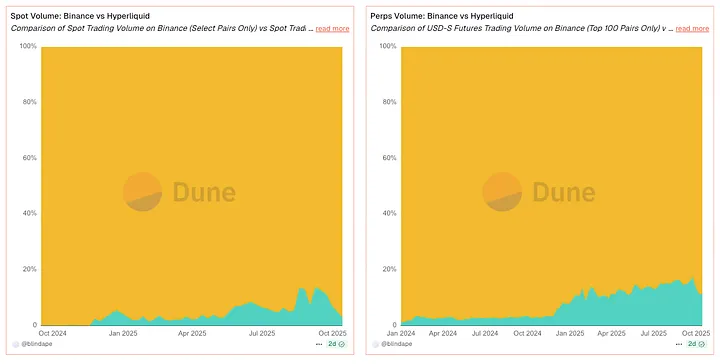
Zooming into the market structure: by mid-2025, DEX perpetual contracts accounted for approximately 20%–26% of global perpetual contract trading volume, up from single digits two years ago. The ratio of futures trading volume between DEX and CEX reached a record of about 0.23 in the second quarter of 2025, which is a clear directional signal indicating that liquidity and users are migrating on-chain.
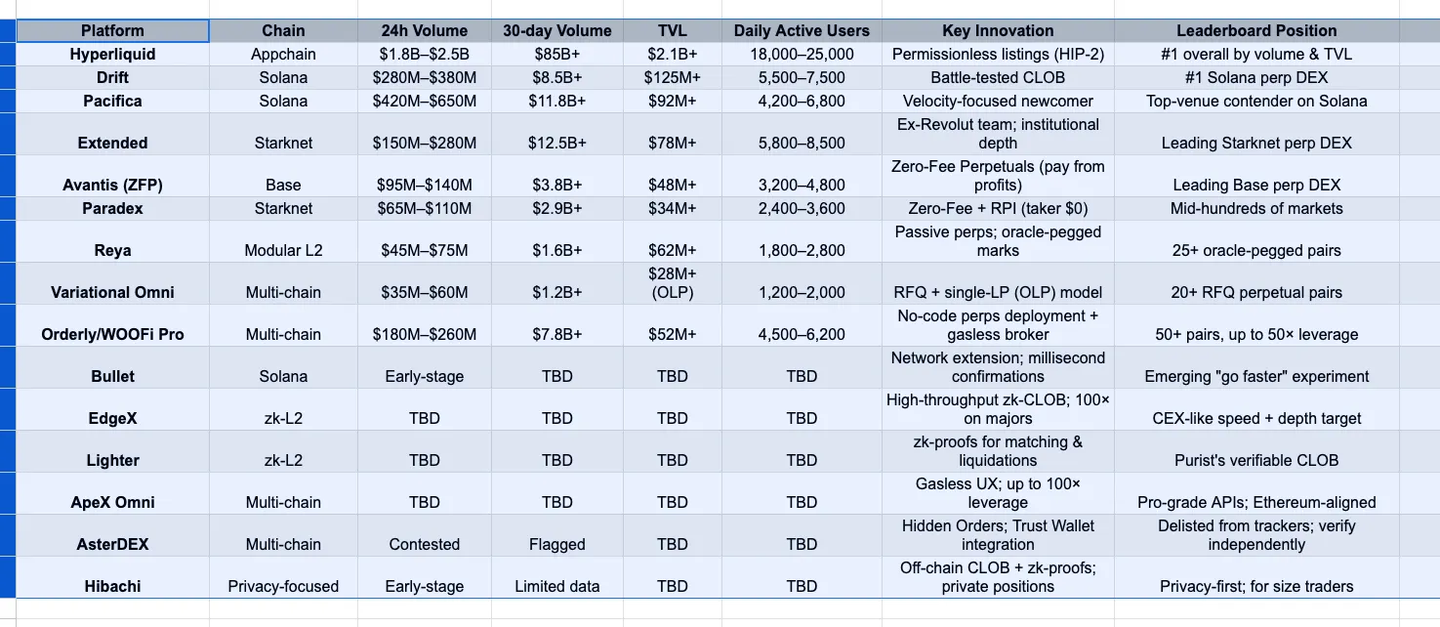
Execution Determines Your Advantage
There are three levers driving profit and loss (PnL):
- Execution and slippage (latency, depth, queuing)
- Liquidation design (mark price vs index price; automatic deleveraging ADL vs insurance fund)
- Fee surface (classic limit orders / market orders vs zero fees / profit sharing)
The following will introduce how each platform utilizes these levers, interspersed with metrics to explain their behavior rather than simply listing tables.
Application Chain CLOBs: When Latency Becomes a Feature (and Reflects in PnL)
Hyperliquid's HIP-3 changed the supply side of liquidity. With listings becoming permissionless (requiring only 500,000 HYPE as collateral), long-tail markets are no longer fleeting. You can see that open interest can withstand the first funding rate cycle without evaporating, and liquidity on the third day/seventh day is still sufficient to accommodate large trades. This stickiness, combined with consistently top-tier daily trading volume, explains why traders now assume Hyperliquid has depth in "niche" trading pairs when planning their trading routes—because it often does.

On Solana, Bullet focuses on speed. During a two-minute period of intense volatility, its "network expansion" design keeps confirmation times in the low millisecond range (Celestia DA, application-specific optimizations). The actual effect is tighter slippage in fast markets: when SOL rises by a fraction in seconds, the execution price is closer to the intended price than on slower stacks. This is not flashy marketing, but rather the basis points saved on each trade.
EdgeX is a zk implementation of the same concept. During macro data releases, the cost for market takers crossing the spread is often only single-digit basis points because its matching engine retains queuing positions. After a month of news-driven trading, this gap accumulates into a meaningful advantage—one of the reasons trading desks consider it a "fast lane" backup option.
A Solana story ties these connections together. When Drift achieved a daily trading volume of $1 billion, market makers compared execution prices across different platforms within the same minute; Pacifica, even while still invite-only, had comparable impacts on BTC/SOL during those windows. The conclusion: Solana's throughput is now shared across multiple platforms, rather than being an exception of a single platform—allowing traders to choose routes based on trading strategy rather than loyalty.
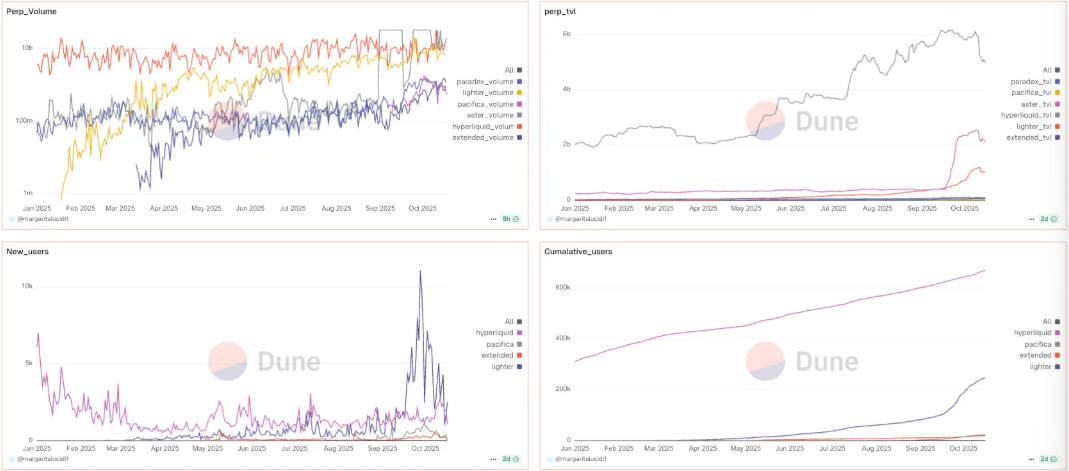
zk-L2 Order Book: Not Just Verifying Results, But Verifying the Engine
Lighter turns "don't trust, verify" into infrastructure. Matching and liquidation are covered by ZK proofs, so price-time priority and ADL paths are auditable state transitions rather than policy documents. You can feel this during market sell-offs: liquidations unfold as documented, and the use of the insurance fund aligns with the pressure path. This is why backtesting results here withstand the test of reality better.
ApeX (Omni) emphasizes user experience without sacrificing custody: no gas fees on the front end, major trading pairs with up to 100x leverage, and CEX-level APIs—all supported by stable daily trading volumes in the hundreds of millions, ensuring that delays in canceling/replacing orders remain agile when funding rates reverse. If you are a high-frequency trader, the key metric is not nominal value, but whether sub-second cancellations remain effective when the order book fluctuates wildly.
Fee Alchemy: The Actual Meaning of "Zero" is "Different"
There are two designs that force you to update your spreadsheets:
- Avantis (Base) removes opening/closing/borrowing fees, charging fees only on profitable closures (ZFP, zero fees / profit sharing). In a month of high-leverage high-frequency trading, you will see PnL variance tighten because fees dragging down performance in volatile markets have stopped consuming your profits. Analysts believe ZFP is significantly different from "discounts": it changes the optimal holding time, especially for short-term trading flows.
- Paradex (Starknet) keeps market taker fees at $0 through retail price improvement (RPI). Whether it is cheaper depends on the spread. During calm periods, $0 market taker fees + improvements usually outperform classic limit order/market order models; during headline news releases, spreads widen, and the results reverse. Paradex's own RPI post is a good introductory guide—the correct metric to track is the effective cost per trade (spread ± improvement), not promotional banners.
A noteworthy dynamic on X is: after quant traders explained RPI on Paradex, they posted costs adjusted for trade size after execution. For volumes below five-digit dollars, RPI usually prevails; above this, depth dominates the fee label. Therefore, real-time adjustments to trading routes are necessary.
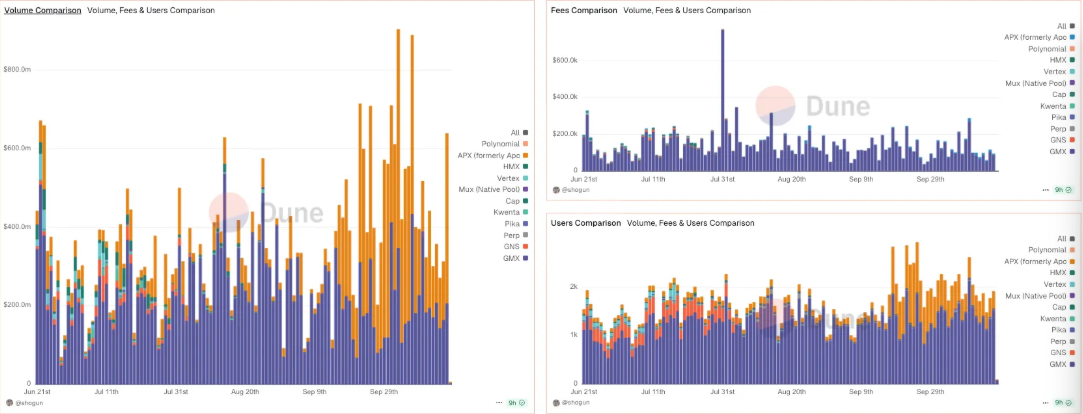
Anchoring Mark Price and Passive Liquidity (Fewer "Why Was I Liquidated?" Moments)
Reya optimizes for clean mark prices rather than raw speed. By anchoring unrealized PnL to a mixed oracle basket, the gap between mark price and index price is smaller during price spikes. In volatile markets, you experience a few more levels of liquidation distance—this could be the difference between being swept out and surviving to face the next K-line.
RFQ: When Certainty Outweighs Time Priority
Variational's Omni replaces public order book trading with request for quotes (RFQ), provided by an Omni LP that hedges between CEX/DEX/OTC and shares the market maker's PnL with depositors. The important number is not nominal value, but the ratio of trades executed at quote size when the order book thins. During a rapid two-minute BTC fluctuation, market takers report higher completion rates than on sparse CLOBs—this is precisely when certainty is worth more than a basis point.
The Shift in Market Share (and Why It Is Sticky)
Three data points form a structural argument:
- By mid-2025, the market share of DEX perpetual contracts will rise to the low to mid-20% range—up from about 4%–6% in 2024. This is not seasonal; it is a growth curve.
- The ratio of futures trading volume between DEX and CEX reached a record of about 0.23 in the second quarter of 2025, echoing multiple market data sources.
- Hyperliquid's permissionless listing and CZ's public discussions amplified this narrative as these ratios reached new highs. The timing is unmistakable: DEXs are no longer marginal players—they have entered the main conversation.
Solana's Three-Tier Ecosystem (How to Plan Trading Flows)
Drift is endurance-focused—maintaining stable depth, cross-margining, and low slippage on major trading pairs with approximately $300 million in daily trading volume. When it exceeds $1 billion in 24-hour trading volume, traders use the same order sizes to compare execution prices across platforms, viewing Drift as the benchmark.
Pacifica is speed-focused—even in its invite-only beta phase, it achieved over $600 million in daily trading volume, with execution prices that can compete with Drift within the same hour, making it a true alternative rather than just a "points quantity."
Bullet is raw speed-focused—serving as a millisecond channel for event trading, where basis point-level slippage is the entire profit of the trade, necessitating routing trades here.
Starknet's CLOB Clusters (No Longer a Science Project)
Extended and Paradex frequently achieve daily trading volumes in the hundreds of millions and hundreds of billions within a 30-day window. Importantly, their characteristics: Extended shows a shallower slippage curve on major trading pairs than a "young" platform, while Paradex's $0 market taker fee is indeed cheaper during non-peak periods—until spreads widen near news events. Real-time adjustments to trading routes are necessary.
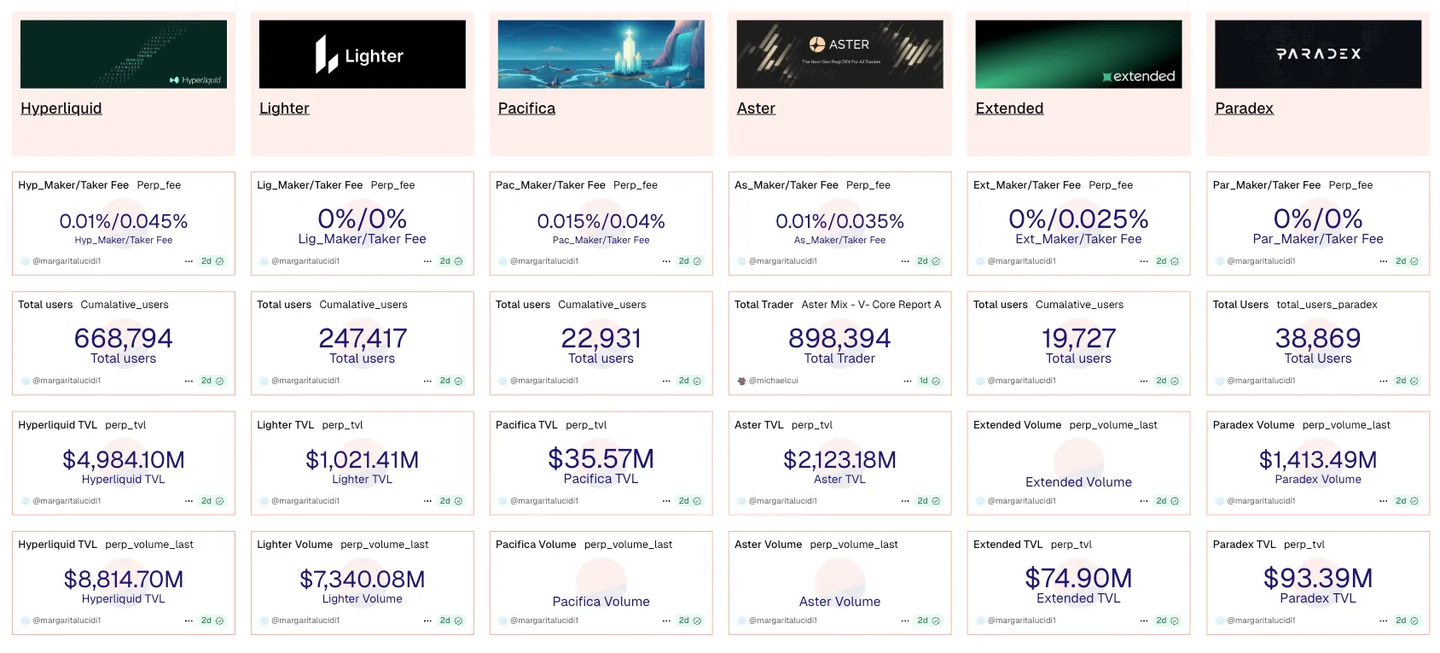
AsterDEX: Functionality vs Depth
Hidden orders are now online. The integration of Trust Wallet has broadened the user funnel. During the same window, third-party trackers flagged suspicious trading volume patterns and delisted perpetual contract data sources. The mature attitude is simple: enjoy the rapid iteration of its features, but only commit large amounts of capital after depth/open interest/fees have been tested against your order volume.
Privacy Without Sacrificing Execution
Hibachi combines an off-chain CLOB with Succinct-style ZK proofs and cryptographic data availability on Celestia, ensuring that balances/positions remain private and provable. The key performance indicator (KPI) is not TVL; rather, it is the quality of execution under privacy—when you do not broadcast inventory, do your execution prices and slippage meet expectations?
Extreme Leverage is a Slogan, Not a Plan
"Up to 1000x" sounds thrilling; under this leverage, a 0.10% adverse movement can lead to automatic liquidation. If you really want to test it, keep your position size very small and set hard stop losses. In practice, using clean 25–50x leverage on a gas-free CLOB (like WOOFi Pro on Orderly) is already sufficient—and easier for risk management.
How to Choose—Practical, Metric-Driven
- Prioritize execution. During CPI/FOMC/ETF meeting minutes releases, measure realized slippage and delays in canceling/replacing orders. If milliseconds and queuing positions are important, application chain/zk CLOBs—Hyperliquid, EdgeX, Bullet, Lighter, ApeX—often come out on top.
- Fees come second. Backtest ZFP (paid from profits) against RPI ($0 market taker fee) based on order size and volatility state; the "cheapest" platforms change hourly rather than monthly.
- Liquidation comes third. When depth thins, lean towards small mark-index price gaps (Reya), proven liquidation paths (Lighter), or RFQ hedging (Variational).
- Always verify liquidity. Use 24-hour/7-day/30-day trading volume and open interest (OI) for common-sense checks—then send real test orders for your trading pairs (not just BTC/ETH).
2026 Configuration, Summarized in One Sentence
Run a speed-focused platform (Hyperliquid/EdgeX/Bullet), a fee model hedging platform (Avantis ZFP or Paradex RPI), and a chain-native option you trust (Drift/Pacifica on Solana; Extended/Paradex on Starknet). Then let latency, proofs, effective fees, and liquidation logic—measured against your order volume—decide where you click to open positions.
免责声明:本文章仅代表作者个人观点,不代表本平台的立场和观点。本文章仅供信息分享,不构成对任何人的任何投资建议。用户与作者之间的任何争议,与本平台无关。如网页中刊载的文章或图片涉及侵权,请提供相关的权利证明和身份证明发送邮件到support@aicoin.com,本平台相关工作人员将会进行核查。
